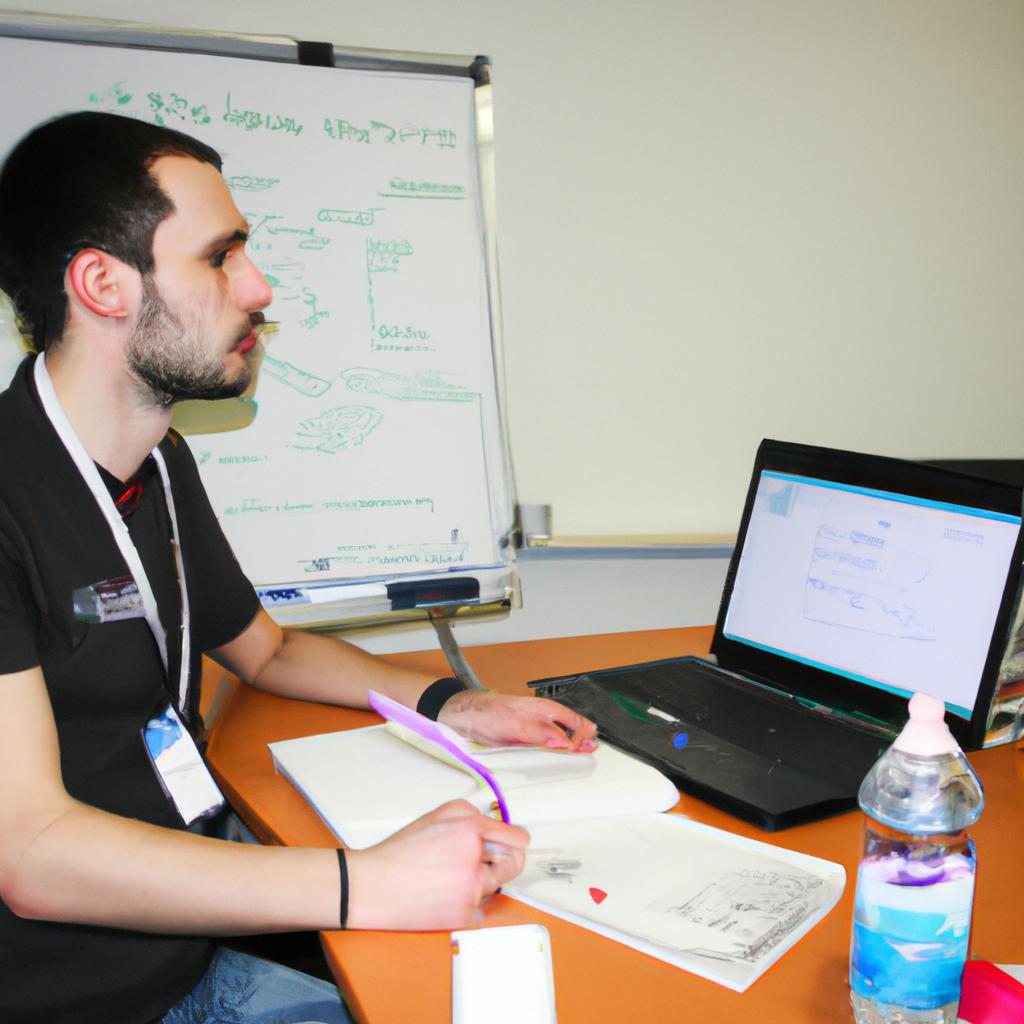Social impact investing, a relatively new approach to finance, has gained significant attention in recent years. This innovative investment strategy aims to generate measurable social and environmental impacts alongside financial returns. By directing capital towards organizations and projects that tackle pressing societal challenges, social impact investing seeks to address the limitations of traditional philanthropy and government funding. For instance, imagine an investor who allocates funds to a research project focused on developing sustainable solutions for water scarcity in developing countries. Through social impact investing, this investor not only expects financial gains but also hopes to contribute to positive change by supporting scientific advancements with real-world implications.
In the realm of science, social impact investing can play a crucial role in advancing research within the social sciences. The field of social sciences encompasses various disciplines such as sociology, psychology, anthropology, economics, and political science. These disciplines aim to understand human behavior, societies, and their interactions with the environment. However, limited resources often hinder researchers from fully exploring complex problems or conducting large-scale studies necessary for generating impactful knowledge. Social finance offers a promising avenue for bridging this gap by providing alternative funding mechanisms that prioritize both financial sustainability and societal well-being. Consequently, it enables scientists within the social sciences to pursue ambitious research agendas geared towards addressing critical societal issues while also ensuring their financial viability.
Through social impact investing, researchers in the social sciences can secure funding that goes beyond traditional grant sources. This additional funding allows them to pursue projects that may require more extensive resources, such as longitudinal studies or interdisciplinary collaborations. By diversifying their funding streams, scientists can have greater independence and flexibility in designing and conducting research that has a direct societal impact.
Moreover, social impact investing encourages collaboration between researchers and investors who share a common goal of creating positive change. Investors can provide valuable expertise and guidance to researchers, helping them refine their research questions and develop innovative approaches to address complex social issues. This collaboration can lead to more practical and applicable research outcomes that have a higher likelihood of being implemented in real-world settings.
Social impact investing also brings accountability and transparency to the research process. Investors are not only interested in financial returns but also in the measurable social impacts generated by the funded projects. This emphasis on impact measurement ensures that research outcomes are evaluated based on their effectiveness in addressing societal challenges, rather than solely on academic metrics.
Overall, social impact investing presents an opportunity for scientists within the social sciences to expand their research horizons and contribute towards meaningful societal change. By attracting investment capital from individuals and organizations committed to making a difference, researchers can tackle pressing issues with more resources at their disposal while aligning their work with financial sustainability objectives.
Understanding the concept of social impact investing
Understanding the Concept of Social Impact Investing
Social impact investing is a financial strategy that aims to generate both positive social and environmental outcomes alongside financial returns. It involves allocating capital to organizations or projects with the intention of addressing societal challenges while also seeking profitable investments. By combining the principles of traditional finance with a focus on creating measurable social impact, this approach has gained significant attention in recent years.
To illustrate its practical application, consider the case study of an investor who allocates funds towards a project aimed at improving access to education in underserved communities. The investment not only seeks financial gain but also supports initiatives that promote equality and empowerment through education. This example demonstrates how social impact investing can be utilized as a powerful tool for driving positive change in society.
There are several key characteristics that distinguish social impact investing from other forms of investment:
- First, it requires clear measurement and reporting mechanisms to assess the social and environmental impacts generated by the invested capital.
- Second, it places emphasis on transparency and accountability, ensuring that investors have visibility into how their capital is being deployed and its corresponding effects.
- Third, social impact investing often involves collaboration between various stakeholders including governments, non-profit organizations, and private sector entities.
- Finally, it necessitates rigorous due diligence processes to evaluate potential investments based on their alignment with desired social objectives.
The emotional appeal of social impact investing lies in its potential to create meaningful change by leveraging financial resources. Through targeted investments, individuals and institutions can actively contribute towards solving pressing societal issues such as poverty alleviation, climate change mitigation, and healthcare accessibility. The following bullet points highlight some emotional benefits associated with this form of investment:
- Fulfilling a sense of purpose by aligning personal values with financial decisions
- Empowering marginalized communities through inclusive economic development
- Promoting sustainable practices for a more environmentally conscious future
- Contributing to long-term systemic changes rather than short-term gains
Moreover, visual representations like tables can help provide a comprehensive overview of the key elements involved in social impact investing. The following table outlines four essential components that contribute to its effectiveness:
| Components | Description |
|---|---|
| Measurable Impact | Clear metrics and indicators are used to measure the social outcomes generated. |
| Collaborative | Stakeholders from different sectors work together towards common objectives. |
| Financial Returns | Investments aim to generate both financial profits and positive social impacts. |
| Scalability | Successful initiatives can be replicated and expanded for wider societal benefits. |
In summary, social impact investing represents an innovative approach that combines finance with addressing pressing social challenges. By incorporating measurable impact, transparency, collaboration, and due diligence processes, it offers individuals and institutions an opportunity not only for financial gain but also to create meaningful change in society.
(Note: Transition into subsequent section) With an understanding of the concept of social impact investing established, let us now explore its application in the realm of scientific research where it holds immense potential for fostering transformative advancements.
Exploring the application of social impact investing in scientific research
Understanding the concept of social impact investing is crucial in exploring its application in various fields, including scientific research. This section delves deeper into the role of social finance in social sciences and examines how it can contribute to addressing societal challenges.
One compelling example of social impact investing in science is the funding of a research project aimed at developing sustainable farming practices to combat climate change. In this case, an investor provides financial support to scientists who are pioneering innovative approaches to reduce greenhouse gas emissions from agriculture. By supporting this research, the investor not only helps address environmental concerns but also promotes economic sustainability by ensuring food security for future generations.
When considering the potential application of social impact investing in scientific research, several key aspects emerge:
-
Collaboration between academia and investors: Social finance offers opportunities for collaboration between researchers and investors with shared values. This partnership facilitates knowledge exchange, accelerates innovation through access to resources, and increases the likelihood of impactful outcomes.
-
Alignment with United Nations Sustainable Development Goals (SDGs): The SDGs provide a framework for targeting global challenges such as poverty, inequality, and climate change. Socially conscious investors can strategically invest in scientific research aligned with these goals, thereby contributing directly to positive social and environmental impacts.
-
Long-term commitment: Unlike traditional grant funding that often focuses on short-term projects or specific deliverables, social impact investing encourages long-term commitments from both investors and researchers. This sustained investment allows for continuous development and refinement of solutions that address complex societal issues.
-
Accountability and measurement: One distinguishing feature of social impact investing is its emphasis on measurable outcomes and accountability. Investors expect evidence-based results that demonstrate progress towards stated objectives. This focus on evaluation ensures transparency and enables stakeholders to assess the effectiveness of their investments accurately.
Table 1 below highlights some potential benefits of incorporating social finance into scientific research:
| Benefits | Description |
|---|---|
| Increased Funding | Social impact investing provides additional financial resources for scientific research, augmenting traditional funding sources. |
| Enhanced Collaboration | Partnerships between researchers and investors foster interdisciplinary collaboration, resulting in innovative solutions to complex problems. |
| Holistic Problem Solving | By addressing both social and environmental challenges, social finance enables a more comprehensive approach to problem-solving. |
| Amplified Impact | Investments in impactful research have the potential to generate broad societal benefits by influencing policies and practices at various levels. |
In conclusion, social impact investing offers an alternative model that can significantly contribute to advancing scientific research in the social sciences. Through collaborations, alignment with global goals, long-term commitments, and accountability measures, this approach has the potential to address pressing societal challenges effectively. The subsequent section will further explore the role of social impact investing in fostering innovation in the field of social sciences.
The role of social impact investing in fostering innovation in social sciences
Exploring the application of social impact investing in scientific research has demonstrated its potential to drive positive change and address pressing societal challenges. This section delves further into the role of social finance in fostering innovation within the realm of social sciences. By considering a hypothetical case study, we can gain insight into how social impact investments have the power to catalyze meaningful advancements.
For instance, imagine a research project focused on developing affordable housing solutions for low-income communities. Through traditional funding channels alone, progress may be slow due to limited resources and risk aversion from investors. However, by incorporating social impact investing, researchers could secure additional capital from individuals or organizations with an explicit interest in creating positive social outcomes. These funds would not only support ongoing research but also enable innovative approaches that prioritize community engagement and sustainable development.
To fully appreciate the potential benefits of social impact investing in science, it is crucial to acknowledge some key factors:
- Alignment of values: Social finance allows investors to align their financial goals with their personal values, enabling them to actively contribute to causes they care about.
- Risk tolerance: Social impact investments often involve higher risks than conventional investments; however, this increased risk appetite can lead to more ambitious projects tackling complex social issues.
- Collaborative partnerships: Engaging multiple stakeholders – including government agencies, philanthropic foundations, and private sector entities – fosters collaborative efforts toward achieving shared objectives.
- Measuring impact: Robust evaluation frameworks are essential for assessing the effectiveness and success of social impact investments. Impact measurement tools help identify areas for improvement and facilitate evidence-based decision-making.
Table 1 below illustrates various ways in which social impact investing can make a difference:
| Potential Benefits | Description |
|---|---|
| Resource Mobilization | Attracts new sources of capital |
| Innovation | Encourages creative problem-solving |
| Scalability | Enables broader implementation of successful initiatives |
| Sustainable Development | Balances economic, social, and environmental concerns |
Examining the potential benefits of social impact investing in scientific advancement will shed light on how this approach can reshape research practices and propel positive change across various disciplines. By harnessing the power of finance to address societal challenges, we can unlock new opportunities for transformative innovation that prioritizes not only academic excellence but also tangible social outcomes.
Next section: Examining the potential benefits of social impact investing in scientific advancement
Examining the potential benefits of social impact investing in scientific advancement
- Examining the potential benefits of social impact investing in scientific advancement
Social impact investing has gained significant attention for its potential to drive positive change across various sectors. In the realm of scientific advancement, this approach holds immense promise by supporting research and innovation that address pressing societal challenges. To illustrate the potential benefits of social impact investing in scientific advancement, let us consider a hypothetical case study:
Imagine a social finance organization focused on advancing education in underprivileged communities. Through their investments, they identify an opportunity to support research projects aimed at enhancing access to quality education for marginalized groups. By providing financial resources and expertise to these initiatives, social impact investors can help researchers develop innovative solutions and accelerate progress towards achieving educational equity.
The potential benefits of such investment strategies in scientific advancement are numerous:
- Increased funding opportunities: Social impact investing opens up new avenues for researchers to secure additional funding beyond traditional grant schemes.
- Broader collaboration: With the involvement of social finance organizations, interdisciplinary collaborations between scientists and experts from diverse fields become more feasible.
- Enhanced scalability: Social impact investors often aim for scalable solutions that can be replicated or expanded, allowing successful interventions to reach wider populations.
- Greater alignment with societal needs: Unlike purely profit-focused investments, social impact investing prioritizes projects that directly address critical societal issues.
To further highlight the advantages of this approach, we present a table showcasing examples where social impact investing has made significant contributions in driving scientific advancements:
| Research Focus | Impact | Funding Source |
|---|---|---|
| Renewable energy | Development of clean | Social venture funds |
| energy technologies | ||
| Sustainable agriculture | Adoption of sustainable | Impact bonds |
| farming practices | ||
| Public health | Accessible healthcare | Philanthropic foundations |
| solutions |
These examples demonstrate how different areas within scientific research can benefit from social impact investing, ultimately leading to positive societal outcomes.
In light of the potential benefits discussed above, it is crucial to also recognize the challenges and considerations involved in implementing social impact investing in scientific advancement. The subsequent section will explore these aspects, providing a comprehensive understanding of the complexities surrounding this approach.
Challenges and considerations in implementing social impact investing in social sciences
Examining the potential benefits of social impact investing in scientific advancement has shed light on the promising role that social finance can play in driving progress within the field. By leveraging financial resources to address pressing societal challenges, such as climate change or healthcare disparities, social impact investing holds great potential for fostering innovation and creating positive social outcomes.
To illustrate this further, let us consider a hypothetical case study: an investment fund specializing in social impact financing decides to invest in a research project focused on developing affordable renewable energy solutions for low-income communities. The funds provided through this investment enable scientists to conduct extensive research, develop prototypes, and ultimately bring their innovative technology to market at a lower cost. As a result, not only are these communities empowered with access to clean and sustainable energy sources, but they also experience improved economic conditions due to reduced energy expenses.
Implementing social impact investing in the realm of social sciences does come with its own set of challenges and considerations. Firstly, there is often a need for alignment between investors’ objectives and researchers’ goals. While investors may prioritize measurable impacts and returns on investment, researchers typically emphasize rigorous methodologies and long-term academic contributions. Striking a balance between these priorities requires effective collaboration and clear communication among all stakeholders involved.
Additionally, monitoring and evaluating the success of social impact investments poses another challenge. Measuring intangible outcomes like improved public health or enhanced education levels necessitates robust evaluation frameworks that capture both quantitative data (e.g., statistics) and qualitative information (e.g., community feedback). This comprehensive assessment approach ensures that valid conclusions can be drawn regarding the effectiveness of specific projects or interventions.
In summary, exploring the potential benefits of social impact investing in scientific advancement reveals its capacity to drive positive change by addressing crucial societal issues through innovative research initiatives. However, successful implementation requires careful consideration of stakeholder alignment and robust evaluation methods. In the subsequent section about “Case studies showcasing successful social impact investments in scientific projects,” we will delve into real-life examples that exemplify the transformative potential of social finance in driving scientific progress.
Case studies showcasing successful social impact investments in scientific projects
While there are several challenges to overcome when implementing social impact investing in the field of social sciences, it is important to address these barriers and consider them within the broader context of driving positive change. By understanding the complexities involved, stakeholders can work towards maximizing the potential of this innovative approach. This section explores some key obstacles and considerations that arise in relation to social impact investing in scientific projects.
Example:
To illustrate one such challenge, let us consider a hypothetical case study involving a research project focused on improving mental health outcomes among marginalized communities. The aim of this project is to develop evidence-based interventions that can be implemented effectively at scale. However, securing funding for this endeavor proves difficult due to traditional grant funding limitations. In such cases, social impact investing presents an opportunity to bridge the gap between financial resources and impactful solutions.
Considerations for Implementing Social Impact Investing:
-
Risk Assessment:
Social impact investments involve risk, as they aim not only for financial returns but also for measurable societal benefits. Conducting rigorous risk assessments becomes crucial to ensure investors’ confidence while aligning with their goals of creating meaningful change. -
Measuring Social Impact:
Accurately measuring and quantifying the intended social impact is vital for attracting potential investors and demonstrating accountability. Developing robust evaluation frameworks allows stakeholders to track progress against predefined metrics, ensuring transparency and credibility throughout the investment process. -
Collaboration and Partnerships:
Successful implementation often requires collaboration across various sectors and disciplines. Engaging relevant stakeholders including researchers, policymakers, philanthropists, and community organizations fosters shared responsibility and enhances the likelihood of achieving sustainable outcomes. -
Long-term Sustainability:
Sustaining positive impacts beyond initial investments necessitates careful planning for long-term sustainability strategies. Identifying potential revenue streams or exploring partnerships with public institutions can help secure continued support after an initial investment period ends.
Table: Examples of Social Impact Investing Outcomes
| Outcome | Description | Emotional Response |
|---|---|---|
| Reduced poverty rates | Lifting individuals out of poverty through targeted interventions. | Hopeful, Empowered |
| Improved educational access | Providing equal opportunities for quality education to underprivileged communities. | Inspired, Encouraged |
| Enhanced environmental | Implementing sustainable practices and mitigating climate change impacts. | Optimistic, Motivated |
| conservation efforts |
Concluding paragraph:
By recognizing the barriers and considerations associated with social impact investing in scientific projects, stakeholders can better navigate this emerging field. Overcoming challenges such as risk assessment, measuring social impact, fostering collaboration and partnerships, and ensuring long-term sustainability will be essential for harnessing the potential of social finance in the social sciences sector. Through careful planning and strategic implementation, we can pave the way towards a future where impactful research initiatives thrive and create lasting positive change within society.
 Wankanyakla Self Help Group
Wankanyakla Self Help Group



